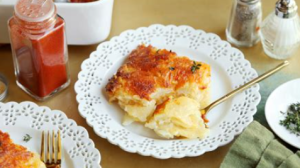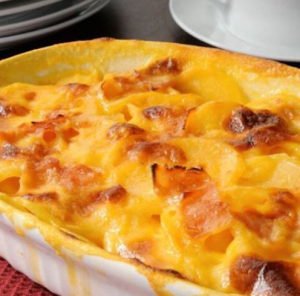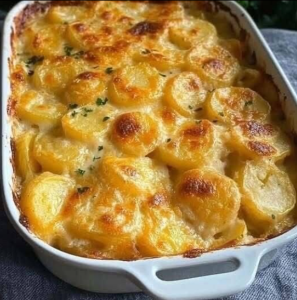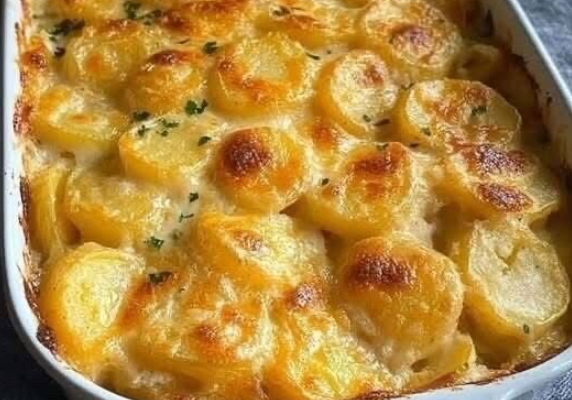
The Best Scalloped Potatoes Ever: A Love Letter to Layers of Comfort
There are dishes that whisper comfort, and then there are dishes that sing it—loud, golden, and bubbling from the oven. Scalloped potatoes belong to the latter. They are the culinary equivalent of a warm hug, a grandmother’s kitchen, a holiday table where laughter lingers long after the plates are cleared. And when done right—when the potatoes are sliced just thin enough, the sauce just creamy enough, the cheese just sharp enough—they become unforgettable.
This is not just a recipe. This is a ritual.
🥔 The Humble Origins
Scalloped potatoes trace their roots to rustic kitchens in Europe, where frugality met ingenuity. The word “scalloped” likely derives from the Old English “collop,” meaning a slice of meat or food. But over time, the dish evolved into a celebration of the potato itself—layered, baked, and bathed in cream or milk.
In France, it’s gratin dauphinois. In Scandinavia, it’s potatisgratäng. In North America, it’s simply scalloped potatoes—though the addition of cheese often nudges it into “au gratin” territory. No matter the name, the soul of the dish remains the same: thinly sliced potatoes, stacked with care, and slow-baked until tender and golden.
🔪 The Art of the Slice
The secret to perfect scalloped potatoes begins with the slice. Too thick, and the layers stay firm and undercooked. Too thin, and they dissolve into mush. The sweet spot? About 1/8 inch—thin enough to absorb flavor, thick enough to hold their shape.
A mandoline slicer is your best friend here. It ensures uniformity, which means even cooking and a visually stunning final product. Yukon Golds or Russets are ideal—starchy enough to thicken the sauce naturally, yet tender enough to melt in your mouth.
🧄 The Sauce That Binds
Now, the sauce. This is where scalloped potatoes transcend their humble beginnings. A classic béchamel—a roux of butter and flour, whisked with milk—is the foundation. But the best scalloped potatoes go further.
Start by sautéing onions and garlic in butter until fragrant. Add flour to create a roux, then slowly whisk in a blend of milk and chicken broth. This combination lightens the sauce while adding depth. Stir in grated Parmesan for umami, sharp cheddar for bite, and a touch of thyme for earthiness. Salt, pepper, and a whisper of smoked paprika round it out.
The sauce should be velvety, not heavy. It should coat the back of a spoon, promising richness without overwhelming the potatoes.
🧀 The Layering Ritual
Butter a baking dish—preferably a square Pyrex or ceramic casserole. Begin with a layer of potatoes, slightly overlapping like shingles. Ladle a third of the sauce over them, then sprinkle with shredded cheese. Repeat twice more, finishing with a generous layer of sauce and cheese on top.
Cover with foil and bake at 400°F for 30 minutes. Then remove the foil and bake another 30 minutes until the top is golden and bubbling. For the final flourish, broil for 2–4 minutes to achieve that irresistible crust.
Let it rest. This is crucial. The sauce thickens, the flavors settle, and the anticipation builds.
🍽️ The First Bite
The fork sinks in effortlessly. Steam rises. The top is crisp, the middle creamy, the bottom infused with flavor. Each bite is a symphony—soft potato, tangy cheese, aromatic herbs, and the subtle sweetness of onion and garlic.
It’s not just food. It’s memory.
👩🍳 Variations and Personal Touches
The beauty of scalloped potatoes lies in their adaptability. Want to make it a meal? Add layers of ham, bacon, or sautéed mushrooms. Prefer a vegetarian twist? Use vegetable broth and add spinach or leeks. Craving decadence? Swap milk for heavy cream and add Gruyère or Fontina.
Some cooks add nutmeg for warmth. Others finish with breadcrumbs for crunch. There’s no wrong way—only your way.
🕰️ Make-Ahead Magic
Scalloped potatoes are make-ahead friendly. Assemble the dish a day in advance, refrigerate, and bake when ready. The flavors deepen overnight, and the convenience is unmatched—especially for holidays or dinner parties.
Leftovers? Even better. The dish reheats beautifully, and some argue it tastes best the next day.
❤️ The Emotional Ingredient
What makes scalloped potatoes the best isn’t just technique—it’s intention. It’s the care in slicing, the patience in whisking, the joy in layering. It’s the memory of a grandmother’s apron, a father’s holiday carving, a child’s delighted first bite.
It’s the dish you bring to potlucks, the one you make when someone’s heart is heavy, the one that says, “You’re home.”
🌟 The Recipe That Wins Hearts
Here’s a snapshot of the best scalloped potatoes recipe, adapted from :
Ingredients
- 2 lbs gold potatoes, thinly sliced
- 1 tbsp salted butter
- ½ cup onions, chopped
- 4 cloves garlic, minced
- 1 cup 2% milk
- ½ cup chicken broth
- ½ cup Parmesan cheese
- 2 cups sharp cheddar cheese
- 2 tbsp flour
- 4 sprigs thyme
- 1½ tsp salt
- ½ tsp pepper
Instructions
- Preheat oven to 400°F. Butter a square baking dish.
- Sauté onions and garlic in butter. Add flour to make a roux.
- Slowly whisk in milk and broth. Add cheeses, thyme, salt, and pepper.
- Layer potatoes, sauce, and cheese—repeat three times.
- Cover with foil and bake 30 minutes. Uncover and bake another 30. Broil 2–4 minutes for a golden top.
- Let rest 10 minutes before serving.
Scalloped potatoes are more than a side dish. They are a story told in layers. A dish that comforts, connects, and celebrates. And when made with care, they become the best you’ve ever had—not just because of how they taste, but because of how they make you feel.
If you’d like a fictional story centered around a character whose life changes over a dish of scalloped potatoes—perhaps a reunion, a revelation, or a moment of healing—I’d love to write that next



